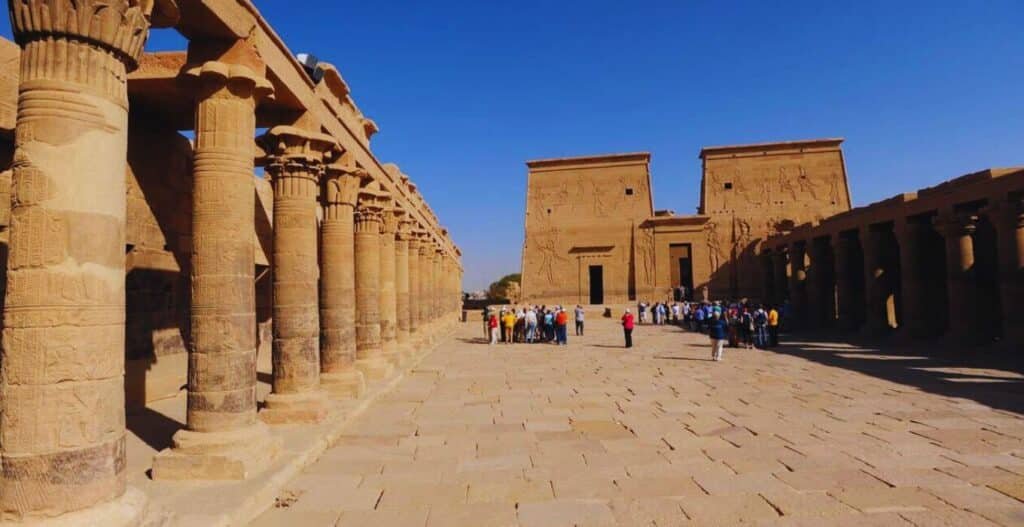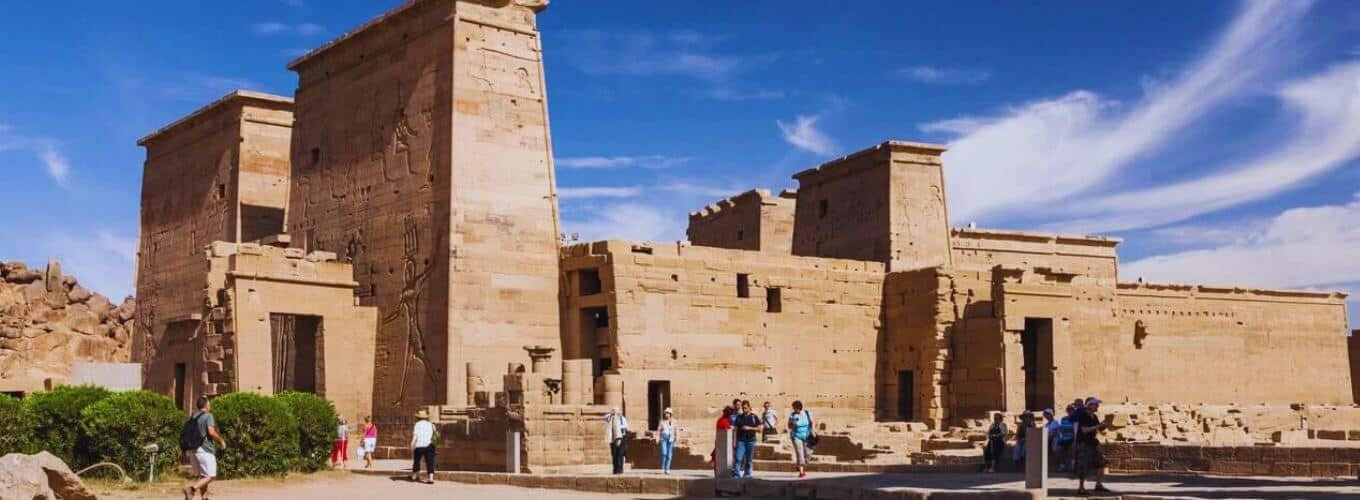Situated in Aswan City, the Philae Temple boasts a remarkable design featuring exquisite granite, polished stones, diverse shapes, and roofs adorned with stunning astrological patterns—innovations not present in the ancient world.
Dating back to the 25th Dynasty, the oldest structure at Philae was later transformed into a temple dedicated to Isis, which still dominates a significant portion of the island.
Within the temple complex is a “mamisi,” or “birth house,” along with a small chapel devoted to the groom of the goddess Osiris. The initial construction was credited to Nectanebo II.
Ascending a flight of stairs from the doorway of the second tower leads to the Hall of Ten Columns, a creation of Ptolemy IX Evargate II. Beyond other chambers lies the sanctuary, a pivotal area within the temple.
Philae Temple served as the ancient focal point for worshipping the goddess Isis. These temples garnered reverence from the Pharaonic era to the Greek, Roman, and Byzantine periods, with each ruler contributing to the structure’s expansion.
The term “Philae” translates to “lover” or “friend” in ancient Greek, epitomizing the dedication of the temple to the goddess Isis, whose cult held tremendous prominence within the Roman Empire.

Philae Temple’s Historical Background
The name (Philae) is Greek, but locally the site is known as Anas Al-Wujud Palace, after a hero from One Thousand and One Nights. Before their gradual submergence in the reservoir created by the old Aswan High Dam after 1902, the clay-covered granitic rocks of Philae, 1,500 by 490 feet (460 by 150 meters), always rose above the highest floods.
Nile Heights. Consequently, it has attracted many builders of ancient temples and shrines. Philae, Abu Simbel, and other nearby ruins were collectively designated UNESCO World Heritage Sites in 1979.
Since the earliest times of Egypt, the island has been sacred to the goddess Isis. The oldest known structures are those of Taharka (690-664 BC), the Kushite Pharaoh of the Twenty-fifth Dynasty.
Alcetes (664-525 BC) constructed the first temple, and Ptolemaic structures reused its parts. Nectanebo II ([r. 360–343 BC]), the last Pharaoh of the Thirtieth Dynasty and the last independent local ruler of Egypt before 1952, added the existing colonnade.
The complex of the Temples of Isis was completed by Ptolemy II Philadelphus (reigned 285-246 BC) and his successor, Ptolemy III Euergetes (246-221 BC).
However, its decoration, which dates back to the later period of the Ptolemies and the Roman emperors Augustus and Tiberius (30 BC–37 AD), was never completed.
Roman Emperor Hadrian (AD 117–138) added a gate west of the complex. Other small temples or shrines dedicated to Egyptian deities include one for Imhotep and one for Hathor and chapels for Osiris, Horus, and Nephthys.
The Temple of Isis continued to flourish during the Roman era and was not closed until the reign of Justinian I (527–565 AD). At the end of Justinian’s control, the temple was converted into a church, and two more Coptic churches were built in the still-flourishing city.
All these structures were thoroughly explored and strengthened (1895–1896) before being partially flooded behind the ancient Aswan Dam. In 1907, a close examination revealed that the salts in the water damaged the decorations’ paint.
When the temples reappeared after 1970 with the completion of the High Dam, it was discovered that significant damage had been done to the shrines. Therefore, a decision was made to move them to higher ground on the nearby island of Agilkia.
The island was flattened to resemble its original Philae, and the temples were rebuilt, restoring some of its original beauty before it officially reopened in 1980.
Osiris Myth
The extensive reliefs within the magnificent Temple of Isis depict various segments of the Osiris myth. On the outer walls’ lower section, depictions of the Egyptian goddess of fertility adorn the surfaces, with Augustus overseeing the exterior decorations.
Emperor Augustus frequently presented offerings to the Egyptian deities while assuming the guise of a pharaoh. Nectanebo I, a Pharaoh from the XXX dynasty, constructed a monastery southeast of Philae, embellished with an exquisite Roman-style entrance resembling a papyrus.
The corridors display two smaller Ptolemaic-Roman temples dedicated to Arensenovis and Mandolis, honoring the Nubian gods. Additionally, Ptolemy V Epiphanes erected a modest temple in tribute to Imhotep, renowned as one of history’s greatest architects. Close to the Philae Temple stands Trajan’s Monastery, an architecturally striking building.
place of pilgrimage
Osiris, known as “the one who lies in coil,” was believed to have been interred within the Philae temple. Hence, the island earned the moniker “Holy Island.” It was revered as sacred, accessible only to high priests. It was a customary pilgrimage destination for the ancient Egyptians at least once in their lifetime.
This stunning temple resides on Agilika Island, south of the former Aswan Dam. Accessible solely by private motorboats, the temple faced the threat of submersion due to the construction of the High Dam. Consequently, it was carefully relocated to its current position, preserving the original architecture and harmonious integration with the landscape during the reconstruction.
Philae, the island housing the temple, was the primary center for worshipping the goddess Isis during the Ptolemaic Dynasty.
Despite the spread of Christianity in Egypt, this complex retained its ancient religious practices, making it one of the few places where the ancient sect persisted. However, it was officially closed in 550 AD.
Subsequently, early Christians repurposed the main temple for their worship, resulting in the defacing of some images of the ancient gods as they sought to eradicate pagan symbols from what they considered their private sanctuary.
The island’s focal point remains the Temple of Isis, while several smaller temples also hold significance and are worth exploring.
Like Egypt’s other renowned tourist attractions, the Temple of Isis features a captivating light and sound show. Yet, this particular spectacle is considered one of the most impressive among such presentations.
The illuminated ruins of the island create an indescribable atmosphere, and visitors are highly recommended to witness this spectacular show during the evening.

Description of the Temple of Isis
The Temple of Isis is one of Egypt’s largest temples, encompassing approximately a quarter of the island’s total area. It serves as the principal focal point on the island, boasting extensive towers and captivating scenes.
Construction initially commenced in the era of King Ptolemy II, followed by subsequent contributions from various Ptolemaic rulers (including Ptolemy IV, V, VI, VII, and XI), who expanded different sections of the primary temple.
Following the architectural style of New Kingdom temples, the Temple of Isis also incorporates Greco-Roman elements, such as the Mammisi (the divine birth house of Horus) and the Nilometer.
The temple structure comprises the imposing first pylon, a grand traditional tower flanked by two towers, leading to an open courtyard that leads to the second pylon.
Located on the left side of this courtyard is the Mamisi, depicting scenes of the birth of the god Horus by his mother, Isis.
Beyond the second tower lies a hypostyle hall adorned with ten columns, followed by three passageways leading to the sanctuary.
Traces of the Philae Temple’s earliest origins trace back to King Taharka of the Twenty-fifth Dynasty, who erected the first shrine dedicated to the goddess Isis.
Additional noteworthy monuments on the island include Trajan’s Kiosk, the Osiris Chapel, the Temple of Horus, the Temple of Hathor, the Tiberius Gate, the Diocletian Gate, and the Temple of Augustus.
Over time, the island’s temples suffered neglect, and some faced destruction during the Christian persecution by Roman emperors. Eventually, during Emperor Justinian’s reign (527-565 AD), the primary temple was repurposed into a church.
An Egypt Nile cruise is the best way to relax, see Nile river tourist attractions, and learn about the culture. This magical trip will give you experiences to last a lifetime, whether you’re a history buff, a nature lover, or just someone looking for a different travel experience.

